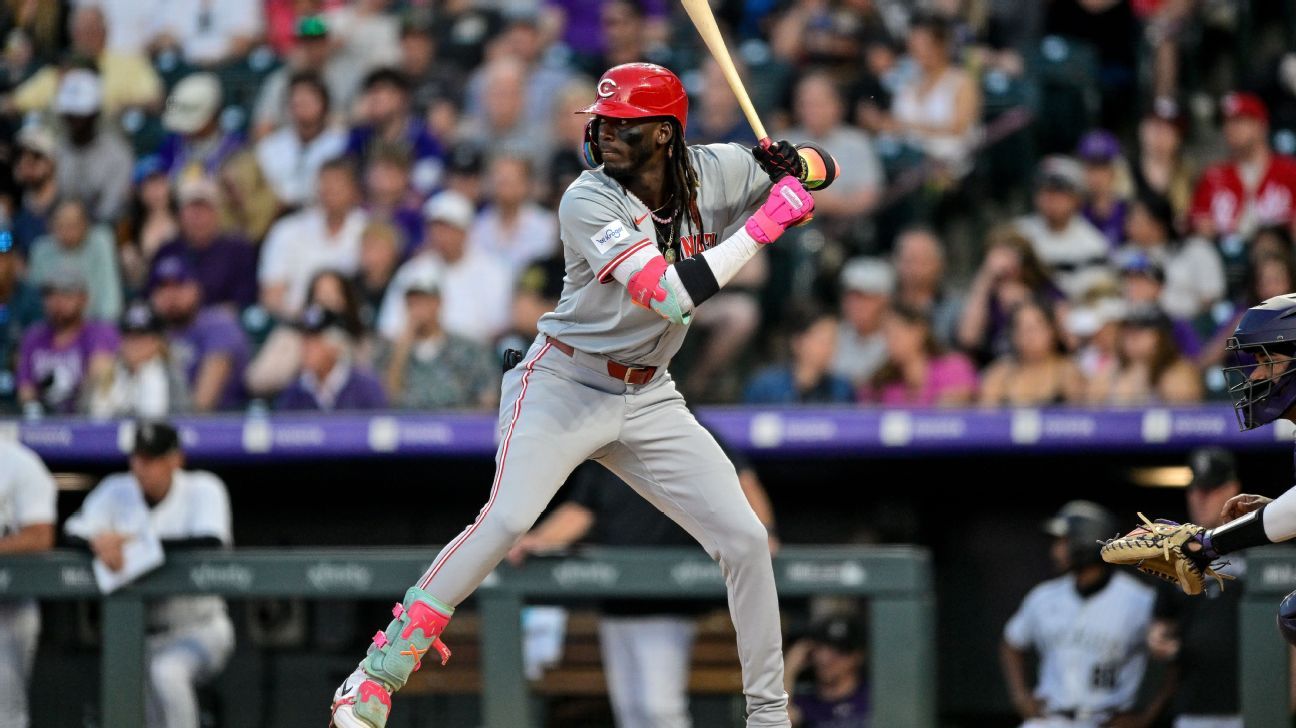The Colorado Rockies celebrate a significant anniversary in their history on Saturday. That date marks the 30th anniversary of the first game at their home, Coors Field, fantasy baseball’s dream venue for hitters.
Unfortunately, in our game, the only ones who should be celebrating are managers of the visiting Elly De La Cruz, and to a lesser extent his Cincinnati Reds lineup-mates. As with any visiting superstar, De La Cruz’s fantasy appeal will increase exponentially during his three-game trip to Coors. For the hosting Rockies, however, there’s little on the roster to generate anywhere near that level of excitement … even on the hitting side.
Thanks in part to their roughly $21 million reduction in payroll this season compared to last — in addition to 22% of their 2025 payroll being tied up in the currently injured Kris Bryant — this year’s Rockies are lacking in hitting punch. While their nine-game sample at Coors thus far is small, the Rockies’ production there is stark:
-
They’re averaging exactly 5.00 runs per game, which would be the second-worst single year average in franchise history, behind only 2004’s 4.89 runs per game.
-
That average has come with a handful of peaks but an abundance of valleys, as five of those nine games saw the Rockies score three runs or fewer. That puts them on pace for 45 such performances, which would shatter the 2024 squad’s single-season record of 37. (The 2023 team, by the way, had a fourth-most 26 of these low-scoring games.)
-
The team is off to franchise record-worst starts in terms of batting average (.255), slugging percentage (.431) and strikeout rate (27.9%). The latter particularly stands out, as a huge spike from 2024’s final 24.7%.
Additionally, it’s not merely year-to-date results that cement the Rockies’ status as one of baseball’s worst teams. My Forecaster projection model grades the current Rockies lineup and bench as the second-worst in baseball, ahead of only the Chicago White Sox. Point out that the team is currently absent the injured Bryant, Ezequiel Tovar, Thairo Estrada and Tyler Freeman, as well as Brenton Doyle, who has been on the bereavement list, if you wish. Activate all five and the Rockies still project to be second-worst.
Time to ditch the old strategy
With the team in a clear rebuilding mode, fantasy managers need to really take a closer look at that “tried and true” Coors Field strategy. No longer should you look to automatically stream Rockies bats and home or to avoid visiting hurlers. Yes, you can keep loading up on visiting hitters, but now you should also consider using visiting pitchers — so long as their skill sets warrant it.
Sure, a home average of five runs per game is still plenty good and a scary rate for an opposing pitcher. So far this season, five teams have met or exceeded that average overall (the Arizona Diamondbacks, Chicago Cubs, New York Yankees, San Francisco Giants and the soon-to-be-visiting Reds), after only three teams did so in 2024 (the Diamondbacks, Los Angeles Dodgers and Yankees).
The Rockies’ strikeout rate, however, is what’s propping up their Coors matchup as being more fantasy-friendly than it has ever been. Again using Forecaster projections, the Rockies should be expected to strike out an MLB-leading 26% of the time this season — a rate that has been exceeded by only eight teams in any full major league season this century (all coming within the past eight years, although that’s still a scarce list even if we limit it only to that time span).
It’s how visiting Washington Nationals starting pitchers MacKenzie Gore (13 Ks) and Jake Irvin (9 Ks) both excelled in their recent Coors starts, on April 19 and 20, both scoring 23 fantasy points. They became the 15th and 16th pitchers to, since the beginning of last season, score 20-plus points as a Coors visitor. Of the 16 to reach that point threshold, 14 struck out at least nine Rockies in the process.
Expanding that, 47 out of the 90 visiting starting pitchers to Coors since the beginning of last season have scored double-digit fantasy points and 30% of them did so while generating at least half that production on strikeouts.
A pitch to start visiting arms in Denver
Tuck that away if you roster strikeout-oriented pitchers from teams scheduled for a Coors trip this season. That includes division rivals Tyler Glasnow and Blake Snell of the Dodgers, who have a league-high seven games at Coors; Dylan Cease, Michael King and Nick Pivetta of the San Diego Padres, who have six more games there; Hunter Greene of the Reds, scheduled to start that Saturday anniversary game; Chris Sale of the Atlanta Braves, who visits next week; Jack Flaherty and Tarik Skubal of the Detroit Tigers, scheduled for a May 6-8 visit; Zack Wheeler of the Philadelphia Phillies; Kodai Senga of the New York Mets; Joe Ryan of the Minnesota Twins; Paul Skenes of the Pittsburgh Pirates; and Yusei Kikuchi of the Los Angeles Angels.
Among less-obvious such pitchers, if their health, role and recent performance match up well in advance of possible Coors starts, you could add to the list guys like Hayden Birdsong of the Giants, David Festa of the Twins, Sonny Gray of the St. Louis Cardinals, Shohei Ohtani of the Dodgers, Eury Perez of the Miami Marlins, Carlos Rodon of the Yankees and Max Scherzer of the Toronto Blue Jays.
Relievers — particularly closers — are also much stronger fantasy plays in Coors nowadays, considering the Rockies might challenge for an MLB-worst win-loss record. Visiting relievers have averaged 9.7 fantasy points per game from a team-wide standpoint thus far in 2025, easily the best such average in the venue’s history.
Ultimately, the only rationale for sitting a strikeout-generating pitcher visiting Coors is if your league’s settings place a premium on starts or innings pitched. Coors outings are still generally shorter and pitchers remain less efficient there than at lower altitudes. Starters have averaged only 5.1 innings and 16.3 pitches per frame at Coors since the beginning of last season, which is slightly below the MLB averages at all parks (5.2, 16.4). As such, you’ll be squeezing less out of your starts and/or innings there than at an average park. The tighter your league’s limit, the more talented the pitcher must be to use there.
So, should I use any Rockies bats at all?
None of this means that the Rockies are completely devoid of viable fantasy plays! Scoring five runs per game is still rather good, and it signals the team’s ability to turn over the lineup and fall into useful fantasy point totals. So, yes, from a daily-fantasy (including our standard game) standpoint, utilizing high-in-the-order Rockies hitters can still be a wise move — but only when your roster lacks a stronger alternative. Sure enough, eight of the 15 times that a Rockies hitter scored at least five fantasy points in a Coors game, it came from one slotted in the top three lineup spots.
Hunter Goodman brings a lefty-mashing stroke to fantasy’s catcher position, as the Rockies have started him there 10 times (and at DH in another nine) out of their 22 games. His free-swinging nature, however, makes him an extreme risk/reward play, meaning his value is his elevated ceiling relative to other catcher-eligibles, and limited only to his Coors contests.
Doyle and Tovar, typically the team’s leadoff and No. 2 hitters when healthy, are slight reverse-split hitters talented enough to be helpful at Coors but not on the road. In Doyle’s case, he has averaged nearly twice as many fantasy points per game at Coors (3.03) than away from it (1.46) since the beginning of last season.
Ryan McMahon has averaged roughly a half-point per game more at Coors since the beginning of last season, with his 1.74 average at home during that time trailing the overall season averages of nine regular third basemen. Picking and choosing his daily matchups might still generate some fruit, however.
Fantasy managers could also get some pop from Michael Toglia against weaker visiting pitchers, steals from Zac Veen against weak pitcher/catcher combinations, and decent hitting stats from Kyle Farmer against lefties. All of that, of course, demands careful consideration of the specific matchups.
But that’s the point, isn’t it? These days, leaning on Rockies at home requires the fantasy manager to do quite a bit of homework in order to find exactly the right situations. In this columnist’s opinion, that increased amount of effort is no longer worth it.
#Fantasy #baseball #Rethinking #Coors #Field #years










